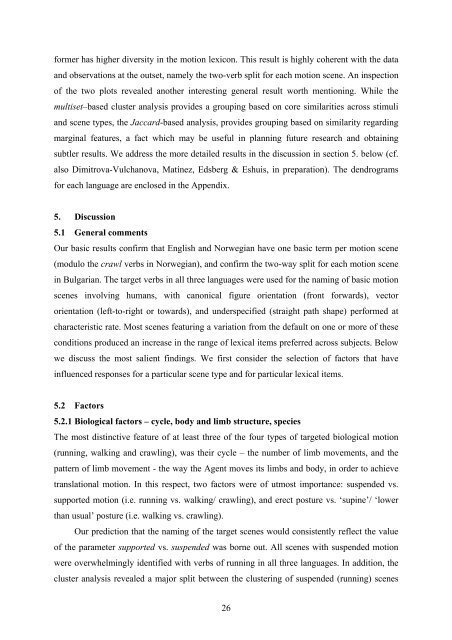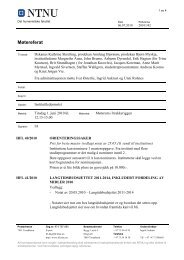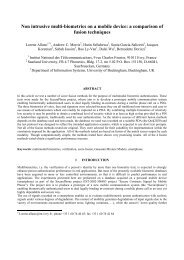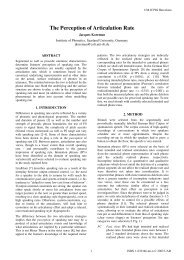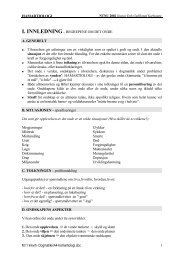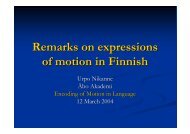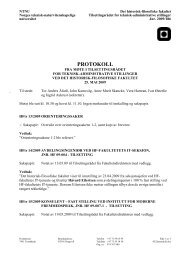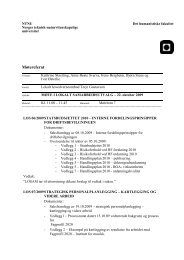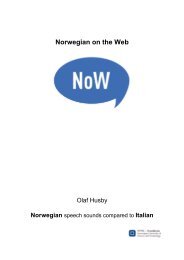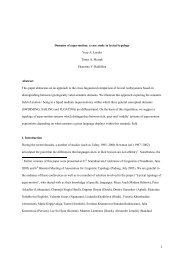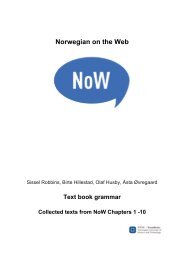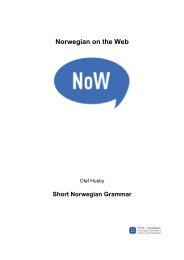In press: In: Dimitrova-Vulchanova, M - NTNU
In press: In: Dimitrova-Vulchanova, M - NTNU
In press: In: Dimitrova-Vulchanova, M - NTNU
You also want an ePaper? Increase the reach of your titles
YUMPU automatically turns print PDFs into web optimized ePapers that Google loves.
former has higher diversity in the motion lexicon. This result is highly coherent with the data<br />
and observations at the outset, namely the two-verb split for each motion scene. An inspection<br />
of the two plots revealed another interesting general result worth mentioning. While the<br />
multiset–based cluster analysis provides a grouping based on core similarities across stimuli<br />
and scene types, the Jaccard-based analysis, provides grouping based on similarity regarding<br />
marginal features, a fact which may be useful in planning future research and obtaining<br />
subtler results. We address the more detailed results in the discussion in section 5. below (cf.<br />
also <strong>Dimitrova</strong>-<strong>Vulchanova</strong>, Matínez, Edsberg & Eshuis, in preparation). The dendrograms<br />
for each language are enclosed in the Appendix.<br />
5. Discussion<br />
5.1 General comments<br />
Our basic results confirm that English and Norwegian have one basic term per motion scene<br />
(modulo the crawl verbs in Norwegian), and confirm the two-way split for each motion scene<br />
in Bulgarian. The target verbs in all three languages were used for the naming of basic motion<br />
scenes involving humans, with canonical figure orientation (front forwards), vector<br />
orientation (left-to-right or towards), and underspecified (straight path shape) performed at<br />
characteristic rate. Most scenes featuring a variation from the default on one or more of these<br />
conditions produced an increase in the range of lexical items preferred across subjects. Below<br />
we discuss the most salient findings. We first consider the selection of factors that have<br />
influenced responses for a particular scene type and for particular lexical items.<br />
5.2 Factors<br />
5.2.1 Biological factors – cycle, body and limb structure, species<br />
The most distinctive feature of at least three of the four types of targeted biological motion<br />
(running, walking and crawling), was their cycle – the number of limb movements, and the<br />
pattern of limb movement - the way the Agent moves its limbs and body, in order to achieve<br />
translational motion. <strong>In</strong> this respect, two factors were of utmost importance: suspended vs.<br />
supported motion (i.e. running vs. walking/ crawling), and erect posture vs. ‘supine’/ ‘lower<br />
than usual’ posture (i.e. walking vs. crawling).<br />
Our prediction that the naming of the target scenes would consistently reflect the value<br />
of the parameter supported vs. suspended was borne out. All scenes with suspended motion<br />
were overwhelmingly identified with verbs of running in all three languages. <strong>In</strong> addition, the<br />
cluster analysis revealed a major split between the clustering of suspended (running) scenes<br />
26


